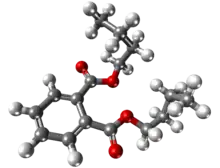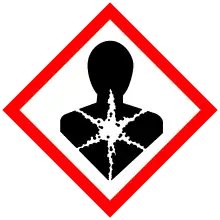Dibutyl phthalate
Dibutyl phthalate (DBP) is an organic compound which is commonly used as a plasticizer because of its low toxicity and wide liquid range. With the chemical formula C6H4(CO2C4H9)2, it is a colorless oil, although commercial samples are often yellow.[3]
 | |
 | |
| Names | |
|---|---|
| Preferred IUPAC name
Dibutyl benzene-1,2-dicarboxylate | |
| Other names
Dibutyl phthalate Di-n-butyl phthalate Butyl phthalate n-Butyl phthalate 1,2-Benzenedicarboxylic acid dibutyl ester o-Benzenedicarboxylic acid dibutyl ester DBP Palatinol C Elaol Dibutyl 1,2-benzene-dicarboxylate | |
| Identifiers | |
3D model (JSmol) |
|
| 1914064 | |
| ChEBI | |
| ChEMBL | |
| ChemSpider | |
| DrugBank | |
| ECHA InfoCard | 100.001.416 |
| EC Number |
|
| 262569 | |
| KEGG | |
PubChem CID |
|
| RTECS number |
|
| UNII | |
CompTox Dashboard (EPA) |
|
| |
| |
| Properties | |
| C16H22O4 | |
| Molar mass | 278.348 g·mol−1 |
| Appearance | Colorless to faint yellow oily liquid |
| Odor | aromatic |
| Density | 1.05 g/cm3 at 20 °C |
| Melting point | −35 °C (−31 °F; 238 K) |
| Boiling point | 340 °C (644 °F; 613 K) |
| 13 mg/L (25 °C) | |
| log P | 4.72 |
| Vapor pressure | 0.00007 mmHg (20 °C)[1] |
| -175.1·10−6 cm3/mol | |
| Pharmacology | |
| P03BX03 (WHO) | |
| Hazards | |
| Main hazards | N), Harmful (Xi) |
| GHS pictograms |   |
| GHS Signal word | Danger |
| H360Df, H400 | |
| P201, P202, P273, P281, P308+313, P391, P405, P501 | |
| NFPA 704 (fire diamond) | |
| Flash point | 157 °C (315 °F; 430 K) (closed cup) |
| 402 °C (756 °F; 675 K) | |
| Explosive limits | 0.5 - 3.5% |
| Lethal dose or concentration (LD, LC): | |
LD50 (median dose) |
5289 mg/kg (oral, mouse) 8000 mg/kg (oral, rat) 10,000 mg/kg (oral, guinea pig)[2] |
LC50 (median concentration) |
4250 mg/m3 (rat) 25000 mg/m3 (mouse, 2 hr)[2] |
| NIOSH (US health exposure limits): | |
PEL (Permissible) |
TWA 5 mg/m3[1] |
REL (Recommended) |
TWA 5 mg/m3[1] |
IDLH (Immediate danger) |
4000 mg/m3[1] |
Except where otherwise noted, data are given for materials in their standard state (at 25 °C [77 °F], 100 kPa). | |
| Infobox references | |
Production and use
DBP is produced by the reaction of n-butanol with phthalic anhydride. These precursor compounds are produced cleanly and cheaply.[3]
DBP is an important plasticizer that allows major engineering plastics, such as PVC, to be used. Such modified PVC is widely used in plumbing for carrying sewerage and other corrosive materials.[3]
Degradation
Hydrolysis
Monobutyl phthalate (MBP) is its major metabolite. doi:10.1007/s40618-015-0279-6
Double saponification of DBP leads to phthalic acid and 1-butanol.[4]
In landfills
DBP has a low vapor pressure of 2.67 x 10−3 Pa. Thus DBP does not evaporate readily (hence its utility as a plasticizer).[5] The Henry's Law constant is 8.83 x 10−7 atm-m3/mol.[4]
As reflected by its octanol-water partition coefficient of around 4, it is lipophilic, which means that it is not readily mobilized (dissolved by) water. Nonetheless dissolved organic compounds (DOC) increase its mobility in landfills.[6][7]
Biodegradation
Biodegradation by microorganisms represents one route for remediation of pollution by DBP. For example, Enterobacter species can biodegrade municipal solid waste—where the DBP concentration can be observed at 1500 ppm—with a half-life of 2–3 hours. In contrast, the same species can break down 100% of dimethyl phthalate after a span of six days.[8] The white rot fungus Polyporus brumalis degrades DBP.[9]
Legislation
DBP is also a putative endocrine disruptor.[10]
European Union
The use of this substance in cosmetics, including nail polishes, is banned in the European Union under Directive 76/768/EEC 1976.[11]
The use of DBP has been restricted in the European Union for use in children's toys since 1999.[12]
An EU Risk Assessment has been conducted on DBP and the final outcome has now been published in the EU Official Journal. To eliminate a potential risk to plants in the vicinity of processing sites and workers through inhalation, measures are to be taken within the framework of the IPPC Directive (96/61/EC) and the Occupational Exposure Directive (98/24/EC)[13] Also includes the 2004 addendum.
Based on urine samples from people of different ages, the European Commission Scientific Committee on Health and Environmental Risks (SCHER) concluded that total exposures to DBP should be further reduced.[14]
Under European Union Directive 2011/65/EU [15] revision 2015/863 [16] (commonly known as RoHS 3), DBP is limited to max 1000 ppm concentration in any homogenous material.
United States
Dibutyl phthalate (DBP) is one of the six phthalic acid esters found on the Priority Pollutant List, which consists of pollutants regulated by the United States Environmental Protection Agency (U.S. EPA).[17] DBP is leached from landfills.[18] However, due to the fact that DBP has a density less than that of water, a thin surface film forms at the air-water interface.
DBP was added to the California Proposition 65 (1986) list of suspected teratogens in November 2006. It is a suspected endocrine disruptor.[10] It was used in many consumer products, e.g., nail polish, but such usages has declined since around 2006. It was banned in children's toys, in concentrations of 1000 ppm or greater, under section 108 of the Consumer Product Safety Improvement Act of 2008 (CPSIA).
An example of DBP's endocrine disruption is shown in one study, in which pregnant female rats were exposed to varying doses of DBP orally from gestational day 12.5 to 21.5. Results showed that DBP down regulates the expression of BcI-2 (inhibit apoptosis) and up-regulates the expression of Bax (promote apoptosis) in male offspring, decreasing the BcI-2/Bax ratio. This results in the increase of apoptosis in the seminiferous tubule cells early in male rat development. In these male offpsrings, in-utero expression of DBP resulted in decreased anal-genital distance, decreased Sertoli cell and Leydig cell number in seminiferous tubule, and decreased sperm production.[19]
See also
References
- NIOSH Pocket Guide to Chemical Hazards. "#0187". National Institute for Occupational Safety and Health (NIOSH).
- "Dibutyl Phthalate". Immediately Dangerous to Life and Health Concentrations (IDLH). National Institute for Occupational Safety and Health (NIOSH).
- Peter M. Lorz, Friedrich K. Towae, Walter Enke, Rudolf Jäckh, Naresh Bhargava, Wolfgang Hillesheim "Phthalic Acid and Derivatives" in Ullmann's Encyclopedia of Industrial Chemistry, 2007, Wiley-VCH, Weinheim. doi:10.1002/14356007.a20_181.pub2
- Huang, Jingyu; Nkrumah, Philip N.; Li, Yi; Appiah-Sefah, Gloria (2013). Reviews of Environmental Contamination and Toxicology Volume 224. Reviews of Environmental Contamination and Toxicology. 224. Springer, New York, NY. pp. 39–52. doi:10.1007/978-1-4614-5882-1_2. ISBN 9781461458814. PMID 23232918.
- Donovan, Stephen F. (1996). "New method for estimating vapor pressure by the use of gas chromatography". Journal of Chromatography A. 749 (1–2): 123–129. doi:10.1016/0021-9673(96)00418-9.
- Christensen, Thomas H; Kjeldsen, Peter; Bjerg, Poul L; Jensen, Dorthe L; Christensen, Jette B; Baun, Anders; Albrechtsen, Hans-Jørgen; Heron, Gorm (2001). "Biogeochemistry of landfill leachate plumes". Applied Geochemistry. 16 (7–8): 659–718. doi:10.1016/s0883-2927(00)00082-2.
- Bauer, M.J.; Herrmann, R. (2 July 2016). "Dissolved organic carbon as the main carrier of phthalic acid esters in municipal landfill leachates". Waste Management & Research. 16 (5): 446–454. doi:10.1177/0734242x9801600507.
- Abdel daiem, Mahmoud M.; Rivera-Utrilla, José; Ocampo-Pérez, Raúl; Méndez-Díaz, José D.; Sánchez-Polo, Manuel (2012). "Environmental impact of phthalic acid esters and their removal from water and sediments by different technologies – A review". Journal of Environmental Management. 109: 164–178. doi:10.1016/j.jenvman.2012.05.014. PMID 22796723.
- Ishtiaq Ali, Muhammad (2011). Microbial degradation of polyvinyl chloride plastics (PDF) (PhD). Quaid-i-Azam University. p. 48.
- "National Report on Human Exposure to Environmental Chemicals". Centers for Disease Control and Prevention, U.S. Department of Health and Human Services. Retrieved 14 March 2009.
- EU Council Directive 76/768/EEC of 27 July 1976 on the approximation of the laws of the Member States relating to cosmetic products
- Ban of phthalates in childcare articles and toys, press release IP/99/829, 10 November 1999
- "Archived copy" (PDF). Archived from the original (PDF) on 21 January 2016. Retrieved 2 January 2017.CS1 maint: archived copy as title (link)
- "Phthalates in school supplies". GreenFacts Website. Retrieved 10 June 2009.
- Directive 2011/65/EU of the European Parliament and of the Council of 8 June 2011 on the restriction of the use of certain hazardous substances in electrical and electronic equipment Text with EEA relevance
- Commission Delegated Directive (EU) 2015/863 of 31 March 2015 amending Annex II to Directive 2011/65/EU of the European Parliament and of the Council as regards the list of restricted substances
- Gao, Da-Wen; Wen, Zhi-Dan (2016). "Phthalate esters in the environment: A critical review of their occurrence, biodegradation, and removal during wastewater treatment processes". Science of the Total Environment. 541: 986–1001. doi:10.1016/j.scitotenv.2015.09.148. PMID 26473701.
- Kjeldsen, Peter; Barlaz, Morton A.; Rooker, Alix P.; Baun, Anders; Ledin, Anna; Christensen, Thomas H. (1 October 2002). "Present and Long-Term Composition of MSW Landfill Leachate: A Review". Critical Reviews in Environmental Science and Technology. 32 (4): 297–336. doi:10.1080/10643380290813462. ISSN 1064-3389.
- Ma, T., Yin, X., Han, R., Ding, J., Zhang, H., Han, X., & Li, D. (2017). Effects of in Utero Exposure to Di-n-Butyl Phthalate on Testicular Development in Rat. International journal of environmental research and public health, 14(10), 1284. doi:10.3390/ijerph14101284
